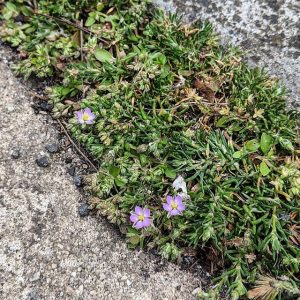Sandspurry (Spergularia rubra), a European annual that made the jump to cosmopolitan weed status in North America, Japan, Australia and New Zealand. This cryptic microgreen is salt-tolerant and preferential to sand and gravel substrates, making it a successful colonist of concrete pavements. In the austral urban, Sandspurry forms loosely perennial patches and runs of shaggy carpet along pavement control joints (particularly kerbside where it is somewhat protected from foot traffic) and around utility covers, always ornamented by its tiny brilliant flowers.
Although the earliest digitised records of the plant date to 1885 in NSW and 1887 in Victoria, the species was reported by Joseph Hooker as being ‘ubiquitous’ in Australia in his 1859 essay. It was addressed similarly in 1864 newspaper coverage of the publication of the first volume of ‘Flora Australiensis’, the Kew-produced work largely based on the remittances of von Mueller. The plant was also reported in an early local list produced by an enthusiast in Ravenswood, south of Bendigo. Although early perceptions of the plant’s ubiquity may have been based upon the misidentification of other Spergularia species (including natives and several species of disputed origin), Sandspurry nevertheless appears to have been a very early invasive arrival, presumably in contaminated seed or building materials.
Sandspurry is not an excessively common weed of Melbourne, but it is prevalent enough once you look for it in concrete and unit paver footpaths and medians. The plants shown here are in Northcote and Doncaster.
View Original Post on Instagram
Search for information about Spergularia rubra in the Flora of Victoria
View information and occurrences of Spergularia rubra on the Atlas of Living Australia











